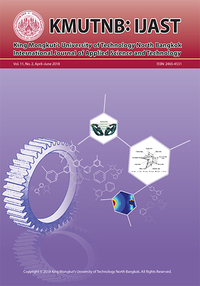Enhancing Capacity Planning through Lean Principles and Simulation: A Case Study of a Local Hospital in Thailand
Main Article Content
Abstract
Healthcare improvement is complicated and has become public concern in Thailand during the past decade. The purpose of this research project is to improve the quality of healthcare and patient satisfaction utilizing Lean principles. This research is conducted in a middle-sized Pluakdaeng hospital in Rayong, Thailand where there are approximately 364 patients daily under the supervision of 6 doctors, 6 pharmacists, 53 nurses and 124 supportive staffs. In Lean studies, computer simulation and Value Stream Mapping (VSM) are utilized to define and eliminate wastes in the hospital business process. Findings indicate that service rate at the hospital can be increased to 28.98% and the average patient waiting time can be reduced to 28.65%. Future work, improvements, limitations and suggestions on the current research are also provided and discussed.
Article Details
References
[2] R. J. Campbell, “Thinking lean in healthcare,” Journal of AHIMA, vol. 80, no. 6, pp. 40–43, 2009.
[3] Z. J. Radnor, H. Matthias, and W. Justin, “Lean in healthcare: The unfilled promise,” Social Science & Medicine, vol. 74, pp. 364–371, 2012.
[4] P. Attkinson and E. B. Mukaetova-Ladinska, “Nurse-led liaison mental health service for older adults: Service development using lean thinking methodology,” Journal of Psychosomatic Research, vol. 72 , pp. 328–331, 2012.
[5] S. Khodambashi, “Lean analysis of an intraoperating management process-identifying opportunities for improvement in health information systems,” Procedia Computer Science, vol. 37, pp. 309–316, 2014.
[6] G. Smith, A. Poteat-Godwin, L. M. Harrison, and G. D. Randolph, “Applying Lean principles and Kaizen rapid improvement events in public health practice,” Journal of Public Health Management and Practice, vol.18, no. 1, pp. 52–54, 2012.
[7] B. A. Fine, B. Golden, R. Hannam, and D. Morra. “Leading lean: A canadian healthcare leader’s guide,” Healthcare Quarterly, vol. 12, no. 3, pp. 32–41, 2009.
[8] N. Burgess and Z. Radnor, “Evaluating Lean in healthcare,” International Journal of Health Care Quality Assurance, vol. 26, no. 3, pp. 220–235, 2013.
[9] W. Ulhassan, C. Sandahl, H. Westerlund, P. Henriksson, M. Bennermo, U. von Thiele Schwarz, and J. Thor, “Antecedents and characteristics of lean thinking implementation in a Swedish hospital: A case study,” Quality Management in Healthcare, vol. 22, no. 1, pp. 48–61, 2013.
[10] P. Mazzocato, R. J. Holden, M. Brommels, H. Aronsson, U. Backman, M. Elg, and J. Thor, “How does lean work in emergency care ? A case study of a lean-inspired intervention at the Astrid Lindgren Children’s hospital, Stockholm, Sweden,” BMC Health Services Research, vol.12, no. 28, pp. 1–13, 2012.
[11] W. Waressara, P. Juta, and S. Peerapong, “A generic discrete-event simulation model for outpatient clinics in a large public hospital,” Journal of Healthcare Engineering, vol. 4, no. 2, pp. 285–305, 2013.
[12] J. Dul, R. Bruder, P. Buckle, P. Carayon, P. Falzon, W. S. Marras, J. R. Wilson, and B. van der Doelen, “A strategy for human factors/ergonomics: Developing the discipline and profession, Ergonomics, vol. 55, no. 4, pp. 377–395, 2012.
[13] S. Dodds, “Designing improved healthcare processes using discrete event simulation,” British Journal of Healthcare Computing, vol. 22, pp. 14–16, 2005.
[14] K. Katsaliaki, S. Brailsford, D. Browning, and P. Knight, “Mapping care pathways for the elderly,” Journal of Health Organization and Management, vol. 19, pp. 57–72, 2005.
[15] W. D. Kelton, R. P. Sadowski, and N. B. Swets, Simulation with ARENA, 5th ed. Singapore: McGraw-Hill, 2010, pp. 631.


